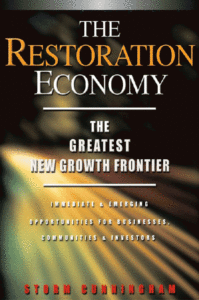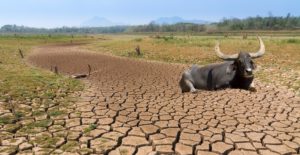In her opening remarks at the Sustainable Land Management (SLM) Business Forum on September 11, 2017 in Ordos, Inner Mongolia, China, the Executive Secretary of the United Nations Convention to Combat Desertification (UNCCD), Monique Barbut, said “Land degradation neutrality in the context of the SDGs is particularly important because it is a very pragmatic and practical way to manage the trade-offs associated with land use. It is about conservation to a certain extent. But it …includes an important element of rehabilitation. Bringing back once-productive resources. There are literally hundreds of millions of hectares of potential in this regard.”
 This represents a crucially-important, but much-belated shift from conservation and sustainability mindset as regards arable land , towards what’s currently referred to as regenerative agriculture.
This represents a crucially-important, but much-belated shift from conservation and sustainability mindset as regards arable land , towards what’s currently referred to as regenerative agriculture.
I say “belated” because the trend was first documented in my (Storm) 2002 book, The Restoration Economy, in a chapter on what was then called “restorative agriculture.”
Mismanagement of forest, farms, and rangelands in developing and developed countries causes widespread land degradation by erosion that removes the fertile topsoil, and practices that cause soil acidification or salinization. A changing climate is exacerbating land degradation processes.
Conservation of soil fertility is always the best first approach, of course, but such programs have been largely ineffective. Farmers desperate to feed their families buy into the promises of chemical and equipment vendors who promise quick productivity increases (at the cost of long-term productivity).
As a result, soil restoration is needed on a massive scale, and regenerative agriculture is catching on fast because it offers farmers a non-capital-intensive was to constantly increase the yields of their now-depleted land.
As societies around the world assess the damage already done to their soil resources4, the job of land rehabilitation and restoration is becoming serious business. While protecting soil quality must be the first priority, it is necessary to restore or rehabilitate land that has already been degraded, in order to avoid net loss of land resources.
Land Degradation Neutrality (LDN) is a new paradigm in environmental politics for avoiding, reducing and reversing land degradation in an integrated way, to attain the Rio+20 aspiration for a land degradation-neutral world.
Actions to achieve LDN include sustainable land management (SLM) practices that avoid or reduce degradation, coupled with efforts to reverse degradation through restoration or rehabilitation of degraded land. The response hierarchy of Avoid > Reduce > Reverse land degradation articulates the priorities in planning LDN interventions.
Crucially, the framework places the investment in the restoration or rehabilitation of degraded land on par with the use of natural resources for development. It creates a pathway to seamlessly integrate in land restoration the actions to mitigate and adapt to climate change and to promote biodiversity.
As further evidence of this shift from conservation to restoration, on July 20, 2017, the 2017 Future Policy Award released a shortlist of the world’s best policies for tackling land degradation, which they described as “one of humanity’s foremost challenges that undermines food security, livelihoods and the health of hundreds of millions of people.”
The six shortlisted policies are from Australia, Brazil, China, Ethiopia’s Tigray Region, Jordan, and Niger. The international 4 per 1000 initiative is also contending for the Future Policy Award.
The prestigious award, which focuses on a different area of policy progress each year, celebrates exemplary laws that create better living conditions for current and future generations.
For this year’s award, the World Future Council teamed up with the United Nations Convention to Combat Desertification (UNCCD) to highlight laws and policies that contribute in two ways:
- First, laws that protect of life and livelihoods in the drylands. Drylands cover close to 40 per cent of the Earth’s land and are extremely vulnerable to over-exploitation, inappropriate land use and climate variability. They are among the most conflict- and drought-prone regions of the world. Droughts, which are getting more severe, frequent and widespread with climate change, are common in drylands, and can amplify tensions within and between communities. In the last century, droughts killed more people than any other weather-related catastrophe.
- Second, laws that advance Sustainable Development Goal 15, target 3, which is to combat desertification, restore degraded land and soil, including land affected by desertification, drought and floods, and strive to achieve a land degradation-neutral world.
Political instability, deforestation, overgrazing and bad irrigation practices can all contribute to desertification. Without action to restore and rehabilitate degraded land, an estimated 135 million people are at risk of being displaced by desertification.
UNCCD’s Monique Barbut describes desertification as “a silent, invisible crisis that is destabilizing communities on a global scale.”
In total, twenty-seven policies and initiatives from 18 countries were nominated. Shortlisted as the world’s best policies to combat desertification and land degradation are:
- Australia: Indigenous Protected Areas programme and Working on Country Indigenous Rangers programme. Indigenous Rangers are at the forefront of tackling environmental degradation right across Australia. 75 Indigenous Protected Areas now make up more than 44 per cent of the National Reserve System and have created the world’s largest contiguous area of protected arid land.
- Brazil: Cistern Programme and the National Programme to Support Rainwater Harvesting and Other Social Technologies for Access to Water. This programme is a participative, bottom-up way to provide water for consumption and for growing food and keeping livestock. It empowers millions of the poorest people in the region to be in control of their own needs, to generate income and enhance their food security.
- China: Law of the People’s Republic of China on Prevention and Control of Desertification. This is the world’s first integrated law dedicated to combating desertification. It provides a framework for China’s National Action Programme and a host of projects aimed at rehabilitating at risk land. Over the last 15 years, China has reversed the trend of desertification. It is no coincidence that the country lifted more than 700 million people out of poverty during the same period.
- Ethiopia’s Tigray Region: Conservation-Based Agricultural Development-Led Industrialization supported by Mass Mobilization Campaigns and the Youth Responsive Land Policy More people less erosion. The Tigray region’s interpretation of Ethiopia’s development strategy focusses on food self-sufficiency and economic growth by conserving land and promoting sustainable agriculture. With unique collective action, voluntary labour and the involvement of youth the people of Tigray are restoring land on a massive scale.
- International: The 4 per 1000 Initiative: Soils for Food Security and Climate. This awareness raising, high-level political initiative communicates a new concept for mitigating climate change through the annual increase in soil organic carbon by 0.4 per cent in the top 30-40 cm of the agricultural soils. It encourages a paradigm shift in agricultural practice.
- Jordan: Updated Rangeland Strategy for Jordan. Traditionally, Bedouin people in Jordan effectively govern their rangelands through their own land tenure systems and grazing rights known as “Hima”. The Rangeland Strategy embraces this holistic concept which integrates natural resources, community life, ethics, animal welfare and more.
- Niger: 3N Initiative ‘Nigeriens Nourishing Nigeriens’ – Strategy for food security, nutrition, and sustainable agricultural development. The initiative is a large-scale and cross-sectoral policy enhancing sustainable agricultural development and socio-economic resilience of farmers and herders. It was developed in an inclusive and participatory process. Since 2011, Niger has reduced the number of people suffering from hunger by 50 per cent.
Featured image (via UNCCD) of a Slovenian lavender farm is by Hedvika Cumilar. It was the COP12 Photo Contest winner.



